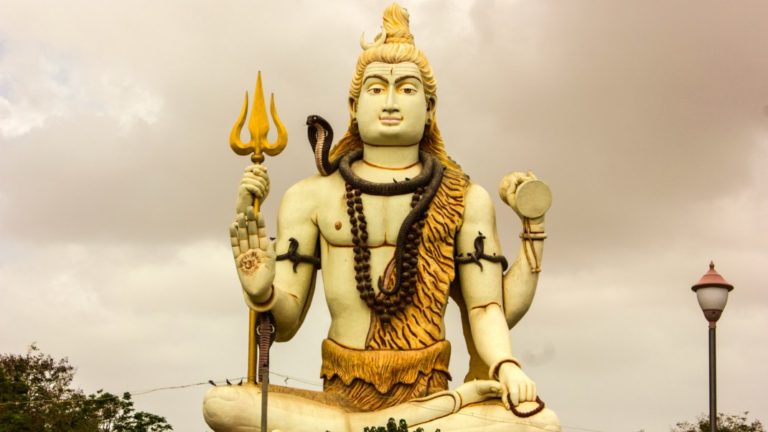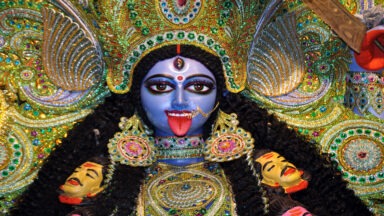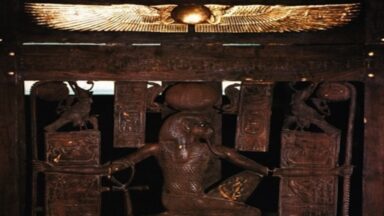Hindu Gods

Hinduism is one of the oldest religions on Earth. It has been practiced nonstop for thousands of years and is still embraced by new generations and, unquestionably, will be for centuries to come. I’ve never lived in the city that didn’t have a Hindu temple of some kind, even if it was small.
Hinduism has been embraced by devotees of every class, nationality, and intellectual and philosophical belief, in almost every country in the world.
It seems safe to say that Hinduism is a religion that can offer something for almost anyone seeking an alternative to a more Western way of thinking, although even monotheism can be accepted within Hindu beliefs.
Expanding Krishna Consciousness
Hinduism’s high visibility in the 1960s made it popular in Western culture, via The Beatles and other famous followers of Maharishi Mahesh Yogi and the Transcendental Meditation (TM) Movement. At first, it seemed to be a fad, but now TM centers can be found in almost every major city in the West.
The International Society for Krishna Consciousness (ISKCON), or the Hare Krishna movement, was another powerful force for bringing Westerners to Hinduism. In college, I would often sit with Hare Krishna members and join them in a simple lunch, eating dried fruit, nuts and drinking buttermilk with grapefruit juice mixed in. They were friendly and filled with a joy that I’ve rarely seen elsewhere. They were deeply devoted. Once mocked, the Krishna movement is now mainstream and has become a part of the religious tapestry of the Western world.
Hinduism: A Living Religion
I feel its important to mention that I’m not a Hindu. It’s also notable that unlike many of the religions of the past, specifically those we label mythologies, Hinduism has been a constant living religion, currently followed by approximately one billion people. It’s impossible for me to properly address the immensity and depth of any Hindu God in this short article. Vast spiritual truths are part of each deity and much can be learned from further study. My intent is to introduce the subject, with a deep respect for the religion itself and those who practice it.
I’ve addressed Hindu goddesses in another article written for Gaia, for those of you who would like more information on this subject.
Indra
Indra is the God of thunder and lightning, as well as storms and the waters that ensue from them. Deities in possession of the thunderbolt can be amongst the most fascinating. Although capable of benevolent energies, they can be mischievous, or dangerous. It seems obvious that this way of looking at things may come from the fact that lightning is indiscriminate in its aim, or so it would seem to we mortals. Indra’s weapon, the Vajra, is an important symbol in both Buddhism and Hinduism, whose meaning takes various forms.
As an ancient deity, Indra is often seen as a savior for mankind from the darkness of evil entities and spirits.
Indra is a deity who fights against ignorance and the oppressive thoughts that keep humans from happiness and progress. An ancient and principal God, his gift is one of flashes of spiritual light and insight, brilliant and indestructible in their form.
Vishnu
Vishnu is sometimes known as the Dreaming God, and is often portrayed reclining upon a gigantic serpent, in a dreamlike state with a lotus growing out of his navel, upon which the god Brahma, and therefore the universe, emerges.
Far from being an ominous situation, Vishnu’s dream is one of maintaining the order of all that exists.
In fact, Vishnu is known as a sustainer and has a role of being a protector, many times over. In order to provide this protection, it is said that Vishnu has had nine incarnations so far, each one allowing order to be maintained. The tenth avatar of Vishnu is yet to come.
The 10 Avatars of Vishnu
1. Matsya
The first appearance of Vishnu as an avatar was in the form of Matsya, half man and half fish.
2. Kurma
As a massive tortoise, Vishnu’s second avatar came to support the cosmos and to help create the nectar of immortality through the churning of the cosmic oceans.
3. Varaha
As a boar, Vishnu rescued the earth, which was in the form of a goddess, from a demon who kidnapped her. He rescued the goddess, killing the demon and once again brought order to the universe.
4. Narasimha
This incarnation brought Vishnu into battle with the demon king, Hiranyakashipu, a tyrant who bullied, persecuted and destroyed those who opposed his rule. Vishnu, in the form of Narasimha, half lion and half man, ferociously beat the demon in combat and destroyed him.
5. Vamana
As this avatar, Vishnu took on the appearance of a dwarf, in order to battle the demon, Bali, who took over the universe and handled it badly. Vamana disguised himself as a monk, a common theme in religious stories, and approached Bali, as the demon was making insincere charitable offerings and prayers, a sin in any religion. Rather than battle, this avatar of Vishnu outwitted the demon king through a wager and regained control of the universe. This particular incarnation always gives me hope, for it shows that violence is not always the answer to problems and that intellect is every bit as important as force in the process of making peace.
6. Parashuurama
This incarnation is a fascinating one. Vishnu appeared as a sage, a man of wisdom, a spiritual scholar and practitioner, wielding an ax. As often happened in history, the military class became too strong and wrested power away from more benevolent rulers, creating a tyrannical and oppressive government. Although seemingly antithetical for an enlightened individual, the use of the ax to destroy an oppressive regime is a symbolic statement of the power of spiritual and intellectual clarity over brut ignorance.
7. Rama
This incarnation of Vishnu brings the god back to earth in the form of Rama, a pious and devoted prince who destroyed the demon Ravana, but not before dealing with several ordeals that got in the way of his being with his beloved wife, Sita. The story of Rama is the subject of the Ramayana, an epic piece of literature with approximately 500 chapters. It is one of the great works of religious devotion.
8. Krishna
Krishna is one of the most popular deities in all of Hinduism. There are numerous stories related to Krishna, many of them focusing on his pranks, heroism and his prowess as a lover. He is usually depicted as having black or blue skin and can be seen playing the flute. His part in the Bhagavad-Gita and his advising of prince Arjuna in battle is wonderfully evocative in its depth of philosophical and ethical investigations.
9. Buddha
Many believe that the ninth avatar of Vishnu was the Buddha. Not everyone agrees with this.
10. Kalki – Yet to Come
This tenth and final avatar of Vishnu will be his last, and will guide us out of what’s known as the Kali Yuga, what we call the common age and all that it entails, including inhumanity, war, deceit and most of the other weaknesses of humans. It is said that after his appearance, as a man riding a horse with wings, everything will be renewed.
Shiva
Shiva is one of the three principal deities of Hinduism. As Brahma was the creator and Vishnu the sustainer, Shiva is the destroyer, although this may be too harsh a way of looking at his process. There is a constant catabolic effect in the universe, consisting of the destruction of one thing in order to provide the energy for another. This is a steady state and is the fiery force that allows transformation to occur.
Shiva is often shown as an ascetic, sitting in meditation and covered with ashes. He has serpents around his waist, wrist and neck and holds a Trident. He also has a third eye in the middle of his forehead, that when open, emits a terrible force that destroys everything it views. He also carries a Demaru, or hourglass-shaped drum, that beats the rhythm of life and death.
Shiva’s wife is Parvati. Their relationship is responsible for one of the most iconic of all Hindu deities, Ganesha, whom will be addressed below.
Shiva’s third eye is partly an indication of the power of meditation and contemplation in the process of destroying desire. His ascetic appearance, complete with nudity and matted hair, shows his lack of concern for the material world. Even though highly spiritualized, Shiva can also be a destroyer and a ferocious opponent of tyranny and abuse.
Shiva is often represented by the lingam, a rounded stone with a symbolic, phallic shape. By placing the lingam on its counterpart, the yoni, the merging of male and female forces, the true imperative of creativity on this planet, becomes manifest. Although lingam stones may be fabricated, the most valuable are usually natural, polished by millennia of rushing waters. They’re said to bestow great spiritual benefits.
Hanuman
Hanuman is an extremely popular deity. He’s shown with the head and face of a monkey and the body of a strong man. Some of the myths attached to Hanuman are cosmological, which speaks to the antiquity of this god. Hanuman is pious and brave, a testament to the courage and intelligence of his character. When Rama’s wife was abducted, Hanuman was instrumental in her return.
He’s often portrayed as a shape shifter and uses both intelligence and determination.
His magical powers and attention to always doing the right thing have certainly contributed to his popularity throughout the world. Hanuman’s [humility and devotion(/article/hanuman-leap-love) are attributes worthy of emulation.
Ganesha
Ganesha is unquestionably one of the most popular and iconic of all the Hindu gods. At one time, I was hard-pressed to know anyone personally who didn’t have at least one statue of Ganesha in their home, whether they were interested in Hinduism or not.
Ganesha did not always have the head of an elephant. The son of Shiva and Parvati, and due to Shiva’s time spent in the wilderness meditating, Ganesha had never met his father. One day, Parvati wanted to take a bath and told her son not to allow anyone inside while she was bathing. At that moment, Shiva returned home and immediately wanted to see his wife, but Ganesha, not knowing who he was, refused him entrance. Enraged, Shiva cut off Ganesha’s head and strode into the bathroom. Discovering his error, he was filled with remorse and realizing his son’s fidelity to his mother’s protection, sought to rectify the problem. An elephant agreed to sacrifice his head and Shiva made it so.
Like Hanuman, Ganesha is an example of a deity that is portrayed by a popular animal in India. Elephants are integrated greatly into the culture and have been a beloved part of Asian civilization for thousands of years.
Ganesha is the remover of obstacles.
He is shown with a broken tusk, but holds the snapped fragment in his hand as a testament to his attention and willingness to help others. He is also shown holding sweets, as he has a weakness for them. It’s common for devotees to leave offerings of candy and milk for Ganesha. Good-natured and wise, he brings a sense of goodness to the world and helps those in need. He is often shown as riding upon a mouse, an incongruence, sometimes said to represent that he rides upon thought, and like a mouse, true goodness can go anywhere.
I hope that the interested reader will delve further into these remarkable deities and the others that exist in the Hindu pantheon. Regardless of one’s religious path, the questions and philosophies put forth are well worth the investigation.
Until next time, I wish you all peace and love.
Inviting the Fierce Feminine Mother Kali Into Your Life

I am particularly fond of participating in or teaching classes themed around the Goddess Kali. Creating an invitation for Kali to enter our life is a way to invite fierceness into our being. She is the powerful and ferocious energy of the feminine mother.
Kali is often referred to in Hindu mythology as the dark goddess, the goddess of doomsday, the goddess of time, and the goddess of death. But once we delve deeper into what she really stands for, we see beyond this doomsday classification. She is ferociously powerful, and in her power, she is the fierce representation of motherly love; a mother’s bold and fiery force of love, as well as her innate desire to protect and support her children.
Kali is a form of Shakti or the feminine universal energy that motivates creativity and fertility. She is also an incarnation of Parvati, the Earth Mother (first wife of Shiva of the Holy Trinity). In this way, she also becomes a feminine counterpart to Lord Shiva, the God of Destruction. Her name has been translated as ‘she who is black’ or ‘she who is death.’
Many of the depictions of Kali show a warrior goddess to be feared. She is often seen wearing a necklace of chopped-off heads and a skirt of severed arms. She wields a knife dripping blood in one hand, holds a decapitated head in the other, and has a red lolling tongue dripping with blood.
As the goddess of time, Kali embodies the true nature of time. She demonstrates how time eventually absorbs all things. She is the ending to the beginnings and middles. Remember also that every ending holds a void of space, or nothingness, and from the space of nothingness, bright new beginnings are generated.





































